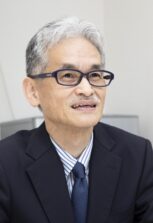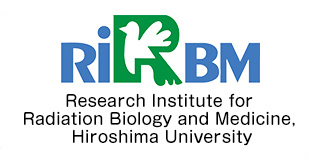 About
About
Message
The Hiroshima University Research Institute for Radiation Biology and Medicine (RiRBM) and Atomic Bomb Disease Institute, Nagasaki University (ABDI) were established 50 years ago to treat atomic-bomb victims and elucidate atomic bomb diseases, and have since that time built a close relationship through atomic bomb disease institute and collaborative research projects. When the TEPCO Fukushima No. 1 Nuclear Power Plant accident occurred, both research institutes dispatched people to Fukushima to give urgent radiation exposure medical care, and we are currently working with Fukushima Medical University to support reconstruction. Based on these achievements, the network-based joint research base of “Radiation Disaster and Medical Science Research Center” was established by the Hiroshima and Nagasaki Institutes and the Fukushima Medical University Fukushima Global Medical Science Center in 2016.
The strengths of the Hiroshima Institute lie in basic biology and medical research, while Nagasaki Institute’s lie in field work and international joint research at Chernobyl and Semipalatinsk, and by stepping up collaboration with Fukushima Medical University Fukushima Global Medical Science Center, which is attempting to revive the medical industry, both institutes are seeking to build a center for comprehensive radiation disaster and medical science research unrivalled anywhere in the world.
We have supported more than 1,600 cases of cooperation and joint research by providing the research assets and techniques of the Center to other researchers in Japan and overseas. In addition, in 2017 we also started 24 triangle projects where we promote collaborative research between the three research institutes.The Radiation Disaster and Medical Science Research Center is working to promote people-to-people exchange and young worker training.
Thank you for your continued support of the Center’s activities.

Joint Usage/Research Center for
Radiation Disaster Medical Science,
RIRBM/Director
Yukihito HIGASHI
Overview of Research Center
Network-type Joint Usage/Research Center for Radiation Disaster Medical Science
Cross-sectional study through knowledge integration of many specialists involved in basic science, clinical research, epidemiology and social science is essential for research in radiation disaster recovery and clinical applications.
The purpose of this “joint usage and research center program” is the formation of a new core for radiation disaster recovery and medical research.

Overview of each base organization
Research Institute for Radiation Biology and Medicine, Hiroshima University (Central Institute)
In order to elucidate the effect of atomic bombs and radiation on the human body and develop methods to prevent and treat diseases caused by radiation, the Hiroshima University Research Institute for Radiation Biology and Medicine (RiRBM) was established in 1961. Genomic damage brought on by radiation will cause acute radiation injury as well as delayed effects such as cancer and leukemia. This research institute is conducting research to 1) elucidate how radiation damages genomic DNA; 2) elucidate how molecular mechanisms lead to cancer as a result of genomic damages; 3) develop new forms of cancer treatment; and 4) develop regenerative medical treatment for acute radiation syndrome. In addition, we have also been active as a global center for radiation disasters research and treatment. We have achieved this by creating an atomic bomb victim database, promoting epidemiological research based on analysis of genomic damage data, and by establishing risk assessment methods that can accurately identify the effects of low-dose radiation on individuals.
Hiroshima University was designated a tertiary radiation exposure medical institution of the western Japan block by the government in response to the Fukushima nuclear accident, so we dispatched an emergency radiation exposure medical team composed of doctors, nursing staff, and radiology technicians in collaboration with the university hospital, and the Radiation Emergency Medicine Promotion Center. In addition, in order to research the health effects of low-dose radiation, which was a major problem after the accident, we started the “Advanced Research Program on the Effects of Low-Dose Radiation” to strengthen research systems such as facility improvement. To gain academic answers about the health effects of low-dose radiation, it is important to know about minor cell damage caused by low-dose radiation and biological reaction. Therefore, the Hiroshima Institute has been working to identify the health effects of low-dose radiation by concentrating its efforts on analyzing the response to and damage on cells due to sustained radiation exposure from low-dose radiation, and by combining the latest leading-edge research techniques and experience and knowledge to research molecules, cells, organs and the individual level of animals.
Hiroshima Institute was selected to be a “radiation effect and medical research center” to serve as a joint research laboratory and joint research center by the Ministry of Education, Culture, Sports, Science and Technology from 2010. Through joint research between radiation researchers all over the country, including the 50 challenges of the Fukushima Nuclear Accident Response Emergency Project, we have provided advanced research facilities and services and supported the academic base for Fukushima reconstruction including research on the effects of low-dose radiation together with radiation effect researchers from all over Japan. Based on such achievements as a joint research laboratory and joint research center, we have expanded as a “Radiation Disaster and Medical Science Research Center” in partnership with the Atomic Bomb Disease Institute, Nagasaki University and Fukushima Medical University Fukushima Global Medical Science Center since 2016.
To realize our principle of contributing to radiation disaster and medical science, raising young researchers over a long period is crucial. Hiroshima Institute has provided a Hiroshima University doctor’s course educational reading program called the “Phoenix Leader Education Program (Hiroshima Initiative) for Renaissance from Radiation Disaster”, under which we have helped to foster new generations of researchers working in the field of radiation disaster and medical science research. This program has conducted educational fieldwork research with the cooperation of Nagasaki University and Fukushima Medical University. The three universities pooling their respective educational assets has been attractive to young students, and this Center together with the Phoenix Leader Education Program have helped to build networks between new post-Doctorate and young researchers and provide a platform for promoting an all-Japan system for research in the field of radiation disaster and medical science.

Research assets / Research equipment
Hiroshima Institute provides services for research techniques and equipment use needed to conduct leading-edge radiology research such as analyzing large quantities of genomes and epigenome (next-generation sequencers), creation of genetically modified mice, and the latest high-throughput image analysis devices. These services are not simply showing students how to use equipment, but also extend to detailed technical guidance by full-time teachers and dedicated technical staff.
In addition, we also provide a wealth of atomic bomb-related research assets. These are atomic bomb and radiation exposure materials including the extremely valuable atomic bomb victim pathology samples and the atomic bomb victim database (ABS), as well as pathology specimens and medical records returned by the Armed Forces Institute of Pathology (AFIP).

Atomic Bomb Disease Institute, Nagasaki University
The Atomic Bomb Disease Institute, Nagasaki University (ABDI) was established in 1962 as an attached facility of School of Medicine to conduct comprehensive and fundamental research on the treatment of and critical prevention of after-effects suffered by atomic bomb victims along with the effects of radiation on the human body. Since then, the Institute has, of course, researched the after-effects of atomic bomb exposure. Since the 1990s, it has provided medical support to victims exposed to radiation at the nuclear power plant of Chernobyl and the nuclear testing ground of Semipalatinsk, and researched radiation-affected molecular epidemiology. Since 2011, the Institute has expanded its activities to cover the Fukushima Nuclear Power Plant. In 2013, the Atomic Bomb Disease Institute became one of the independent Institutes of Nagasaki University to dedicate its efforts to research and education in line with the needs of society.
The Institute is currently developing research based on its re-defined mission, which is to “promote radiation exposure medical treatment studies focusing on radiation-based health risks in partnership with universities and research institutions in Japan and abroad, and to produce experts dedicated to the safety and security of mankind.” The Institute is conducting research on radiation damage at a molecular level, specimens with genomes as an index, radiation carcinogenesis at a cellular level, and thyroid cancer using human specimens and model animals. Based on such research, the Institute had adopted a broader field of research including epidemiological research, international studies of radiation-exposed victims, and medical treatment cooperation. It currently stands as a research institute that covers various levels of research spanning from fundamental research to social medicine. In addition, it also serves as a center of information about atomic bomb disease treatment. Specifically, it has saved and stored data over a long period about the atomic bomb victims of Nagasaki; it has become an atomic bomb victim cancer tissue bank in recent years; and provides links to pathology and atomic bomb information.
In this institute, there are four main units and one center.
(1) Radiation Risk Control Unit
This Unit promotes research on the effects of radiation on the human body while also conducting clinical and molecular epidemiology studies internationally and locally. This Unit is a foundation of educational research with risk assessment and risk communication at its core. It also serves as a hospital and has been promoting educational research programs to contribute to radiation damage medical treatment and relief medical care in collaboration with associated institutes in Japan and abroad. It has also been promoting health and life science in the domains of cancerous and non-cancerous diseases through social medicine and molecular biological approaches. Its research is conducted by the the four departments of Radiation Medical Sciences, Global Health, Medicine and Welfare, Radiation Biology and Protection, and Radiation Molecular Epidemiology.
(2) Cellular Function Analysis Unit
This Unit analyzes the effects of radiation on organisms at a cellular level. It also elucidates the pathogenesis mechanisms of various diseases including malignant tumors caused by radiation and aims to develop new treatment methods from perspectives of stem cell (including cancer stem cells) and homeostasis. Its research is conducted by the two departments of Stem Cell Biology Molecular Medicine.
(3) Genomic Function Analysis Unit
Focusing on changes to genomic DNA, this Unit researches genome variation and restoration processes, and genetic disorders caused by genomic alterations. Its research is conducted by the two departments of Human Genetics and Genome Repair.
(4) Atomic Bomb Disease and Hibakusha Medicine Unit
This Unit conducts a wide variety of medical treatments for physical anomalies and diseases caused by exposure to radiation from, for example, an atomic bomb. It also researches the effects of radiation on the human body. Its research is conducted by the three departments of Hematology, Tumor and Diagnostic Pathology, and Radioisotope Medicine.
(5) Center for Promotion of Collaborative Research on Radiation and Environment Health Effects
This Center’s main activities include the promotion of radiation health risk control international strategy center program, and cooperation based on the comprehensive written agreement with Kawauchi-mura in Fukushima Prefecture. It is made up of the Division of Strategic Collaborative Research, Division of Scientific Date Registry (Biostatistics Section/Tissue and Histopathology Section), Representative Office of Nagasaki University in Belarus, and Nagasaki University-Kawauchi Village Reconstruction Promotion Base.
Research assets / Research equipment
The Nagasaki University Institute (ABDI) provides assets vital for fieldwork that have been praised all over the world. These include atomic bomb-related materials and samples adaptable to the latest research techniques, networks with local people fostered through activities in radiation damage regions in Japan and abroad, the Chernobyl molecular epidemiology research project center, and the Nagasaki University and Kawauchi-mura reconstruction promotion center.
As a facility for biological and medical research, it provides X-ray irradiation equipment, genome analysis equipment, radioactivity measurement apparatus (whole body counter for living bodies, germanium semiconductor radiation detector), molecular imaging equipment (PET/SPECT/CT for small animals), and so on.

Fukushima Global Medical Science Center, Fukushima Medical University
As a medical center aimed at the reconstruction of Fukushima following the Great East Japan Earthquake and the associated TEPCO Fukushima Daiichi Nuclear Power Station accident, the Fukushima Global Medical Center was established in November 2014. This Center conducts the Fukushima Health Management Survey, provides leading-edge medical facilities, builds medical treatment systems, and promotes the development of the medical industry. Through these efforts, it plays a central role in the development and revitalization of the local community and conveys this message of reconstruction to the outside world. It also helps to educate medical staff to bring expertise to the international stage.
The main organizations in the Center are as follows.
1. Radiation Medical Science Center for the Fukushima Health Management Survey
Fukushima Medical University was assigned by Fukushima Prefecture for the below objectives to conduct “The Fukushima Health Management Survey”, and established the Radiology and Health Management Center for Residents of Fukushima Prefecture in September, 2011 to act as a managing body of the said survey to protect the health of the prefecture’s residents.
(Objectives of the Prefectural Residents Health Survey)
To evaluate the radiation dose of prefectural residents and identify the state of their health due to the proliferation of radioactive substances from the TEPCO Fukushima No. 1 Nuclear Power Plant accident and the evacuation of residents, and to maintain and improve the health of the prefecture’s residents in the future by using this collected data for prevention, early discovery and early treatment of diseases.
The Prefectural Residents Health Survey consisted of a total of five surveys. These were the “Basic Survey”, which estimates the external radiation exposure in the period when the air dose rate was the highest, and four more detailed surveys consisting of a “health examination”, “thyroid examination”, “survey of degree of mental wellbeing and lifestyles”, and a “survey of pregnant women”.
2. Advanced Clinical Research Center
This Center was established as a base to conduct early diagnoses of various diseases through image diagnosis with cutting-edge medical equipment.
The Center also aims to raise the level of medical treatment and research by developing an environment to facilitate processes from the production and synthesis to the nonclinical test and clinical research and trial of pharmaceuticals. It is also surveying and analyzing radioactive substances in the environment in collaboration with the National Institute of Radiological Sciences.
To conduct these activities effectively, the Center has been organized into four departments: the Molecular Imaging Department, the Molecular Treatment Department, the Clinical Research and Treatment Department, and the Environmental Dynamics Survey Department. It is helping to maintain and improve the health of the prefecture’s residents in the future through a strong partnership between these departments.
3. Translational Research Center
This Center was established in 2012 to establish the Fukushima Translational Research Project as part of the university’s Fukushima reconstruction project. By building a bridge between “medicine” and “industry”, it seeks to provide multifaceted support for development such as new treatment and medicines, diagnostic drugs, and test reagents for various diseases, especially, cancer. Through these efforts, it is creating a world-class pharmaceutical product development center through the Fukushima Medical University, and contributing to the revitalization of local industry and the reconstruction of Fukushima.
Specifically, it is collaborating with the Fukushima Medical University Hospital and cooperating hospitals inside and outside Fukushima Prefecture, and creating a corporate consortium with medical-related industries such as pharmaceutical companies to promote leading-edge R&D in line with industry needs and the commercialization of research findings while creating pharmaceutical product centers in places other than Fukushima.
Research assets / Research equipment
The Fukushima Global Medical Science Center is planning to provide cyclotron-related facilities in addition to prefectural residents survey-related fieldwork. RI tracer research used for the advanced diagnosis and treatment of cancer enables the use of first-rate domestic facilities such as PET/CT and PET/MRI and the provision of knowledge by dedicated staff.




